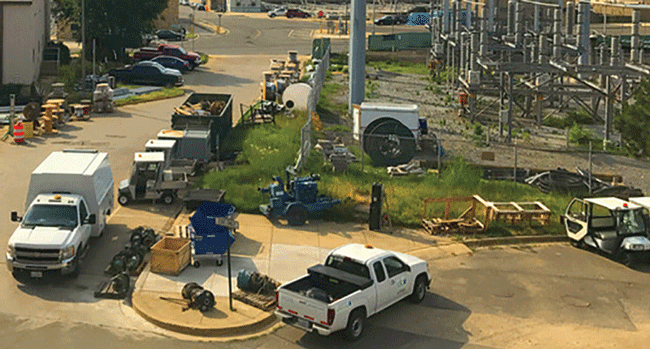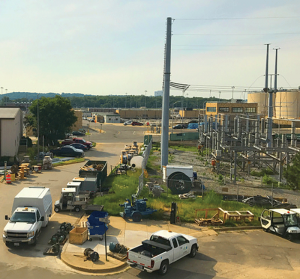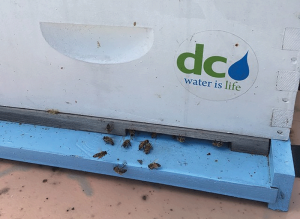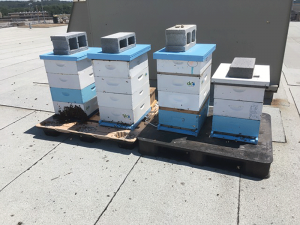A Bunch Of Other Machinery, Too.
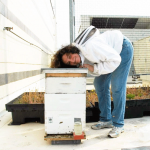
Find me online!
www.twitter.com/tonibee
www.citybees.blogshop.com
I recently told a reporter (who wasn’t there for me) that this should be her headline: Largest Sewage Treatment Plant Uses Child Labor to Harvest Honey from Wastewater. That’s because DC Water, operator of the Blue Plains Wastewater Treatment Facility and drinking water supplier to the nation’s capital, had held its first-ever honey harvest at Washington’s Maury Elementary School. On May 31, third graders who’d studied bees all year harvested frames, built native pollinator nests, decorated hive bodies, took honey home, and generally had a sticky and noisy good time. Though no one liked my headline, the honey has serious fans.
It is easy to sell this story by starting out with a happy ending about the unlimited potential of urban beekeeping. I would, however, be skipping a couple of rough winters and lessons learned along the way, some that might help you or others searching for an unlikely-yet-sustainable urban apiary. Or maybe slow you down a bit.
Urban beekeepers are constantly looking for those unthought-of apiary locations: just this week, an official mentioned that there are currently 261 registered hives in DC–which we all know means that there are at least 500 within our 68 square miles. That’s a sneer-worthy figure for cities like London, which had over 3,300 known colonies five years ago. Here, a minority of of us own something as ordinary as a backyard. Some of us don’t get access to the roof over our heads. Many spend weeks, or months, wracking their brains in the search for space and apiary possibilities. As a result, they roll the dice from time to time in the hope that unusual apiaries will work out.
It’s all a crazy hard problem to work out as a beginner. If beekeeping is about the welfare of pollinators, however–especially honey bees–and a green future as well as contributing to the environment, caring beeks might ask, “Is more always a good thing?” and “does every setting offer potential for bees?” even while many are seeking out their first chance.
This continued growth is a surprise. Years after the disappearance of Colony Collapse Disorder, which placed problems facing beekeeping on center stage, we still attract more urbanites than we can seat in courses. They set up and register more hives every year, and more would if they could find a patch on which to place one (or two, or four, which we know is where these things go). Bees not only show up on surprisingly healthy residential roof tops, or green roofs on fashionable LEED-certified office blocs, but in places that push the edges of experience and established practice. This article shouldn’t hinder that exploration, but tell a tale that says it must work for the bees first–and that might take a while to work how.
Here’s how we ended up keeping bees at the most industrial site in DC, why we tried, and how we have finally seemed to get it right. Probably.
For three years, DC Water has hosted four colonies of honey bees. It took two years before that to get the bees their security pass, and it was only this year that DC Water went public. Why? Because you don’t mess around with the Capital’s water supply, and no one involved thought it was necessarily a slam dunk. And it wasn’t. Five years in, this was our first harvest, and much honey came from colonies we consolidated to survive the winter.
DC Water is one organization, of any category, which I admire most. They employ, and sometimes create, emerging technology that pushes our water quality to the edge of current limitations. They engage in mind-bendingly creative and effective financial dealings that allow them to revolutionize the water infrastructure of DC, and they recycle poop into “Bloom,” a freely distributed soil additive that you could eat if you wanted to (though few do: the third graders and I made seed balls out of it). The Bloom guys, Bill Brower and Chris Peot, made the Blue Plains Bees possible.
You will not be able to start an apiary at a public utility by calling someone up and asking, however. We got our chance because DC Water was not our first rodeo. We long ago realized that we had to weave ourselves into the DNA of community organizations, initiatives, government agencies, churches, and more to become ordinary enough to survive. Ordinary. Maybe even boring. We had to be a trustworthy part of it, not renegades. So, we ventured into community gardens, hotels, food banks and schools. We run the honey contest for the DC State Fair, we signed agreements with Parks and Rec, and teach in cooperation with the University of DC’s Extension Service.
We needed that experience to work with DC Water, much of it to deal with the two-year set up phase. We met and listened to union reps, HR, safety officers, management – and they visited our apiaries. Community meetings took place onsite. Questions were asked, discussions were had, proposals were drafted, agreements were negotiated. I went through a security process, and can work with only two people at the plant, no helpers from my club. This may seem Orwellian, but the reasons for the caution seem to be important for urban beekeepers pursuing unlikely sites anywhere. We had to work out who had access to the bees and how; procedures for avoiding and responding to problems; dealing with non-beekeeper folks whose jobs put them in contact with the bees; deciding who owned the bees; who had liability for what; how to get bees in and out of there; times and means of access – you get it. We had to imagine way more angles than the average urban apiary, but everyone with an out-apiary faces at least a half a dozen of these issues.
It was no accident that we set up on the roof of the Central Maintenance Facility (CMF), a three-story office building, rather than an industrial shed. Management was demonstrating that this was in line with major green goals, and they were not afraid. The relatively low elevation of the CMF was promising in light of the consistent, prevailing winds that blow over the plains which stretch from a forested ridge to the Potomac River. Greater altitude would magnify the wind. Both the undeveloped river edge and the mass of trees were in plain view of the roof (across a bunch of industrial pipes and trucks and processing pools).
This is, however, the most difficult apiary I ever managed. A lot of it came from those winds and the illusory nearness of forage and fresh water. Another part was discovering that key information was in the hands of others, and I knew about neither the info nor the contact person.
For instance: throughout Year One, there seemed to be no shortage of water and no reports of bees drinking from inconvenient locations. However, in late summer we saw spectacular dwindling accompanied by low mite counts and decent amounts of honey. Theories were advanced, feeding happened, colonies were consolidated, and losses still took place. In December, however, one of the HVAC guys showed my contact the equivalent of a heaping shoebox full of dead bees that he had taken out of a roof ventilation unit. The second or third, he said. It turns out that we had lost the equivalent of at least four packages of foragers into an important building mechanical system (requiring the technician to intervene!) at a time of great dearth and the production of winter bees without figuring it out, in part because we saw rivers and pools. The staff did not know that what they were seeing was important to us, also.
Getting bees to go to the right water is a challenge in any high-population setting. Here, we had to get serious and enlist other people to make sure that the water offered was more attractive and available, and a whole lot closer than any ventilation rig. I needed folks to keep the water station filled more often than I could visit, and this year we will add Boardman feeders full of water to the landing boards.
We also learned lessons about which winds to worry about most: we thought winter gusts were the ones to avoid, but it turned out that prevailing Spring and Summer winds were a bigger deal in hampering effective orientation, and increasing the energy cost of each foraging excursion. We noticed that even light winds accentuate drift to the end-most colony in our row.
In 2015, PLOS ONE published a paper by Dr. Tarpy’s lab at NCSU (Youngsteadt, Appler, López-Uribe, Tarpy, and Frank. November 2015. Urbanization increases pathogen pressure on feral and managed honey bees, http://tinyurl.com/pfvunhc that I read then and to which I often refer. The researchers observe that many urban colonies share patches of forage and may travel longer distances around their hives to find it: “poor habitat quality within this radius would impose additional stressful, above-average flight distances.” That average distance is 1,500 meters. If you look at the photo here of the ridge on the other side of the plant, that is about 900 meters away. Yikes.
Even though our roof was far lower than many residential and commercial buildings with booming apiaries, the geography of this huge plain by a river required its own calculus, and we had to learn how to do the math. Now, we are moving the entrances to the more sheltered side to see if this helps with orientation and drift, and we are watching the end colonies more preemptively for swarming. We re-balance strength by moving capped brood to the colonies which appear to be donating foragers. New colonies are going to be fed longer and more. Pollen patties will be more frequently on the menu. We’re getting an anemometer and a hive scale.
At this industrial location, we just have to get everything more right, or figure out how to get everything to a higher standard, than a beekeeper in a more typical or better understood environment. We also doubt that all locations are created equal, or that these special problems are going to be universal. We must be humble, we should pay lots of attention, we must worry more. It had better be worth it!
When we did get our harvest, the shared power of the apiary, the organization, and the community was intoxicating and hopeful. The kids closed the loop on learning that started with dissecting flowers in the Fall, moved through bee biology, and ended with honey spun out of frames they uncapped. Beekeepers, teachers, parents, and wastewater professionals helped kids crank extractors and dribble honey into bears. No one will forget the human connection, and they certainly won’t forget the bees. For such a reward, it is on us to make this work even better for the bees, and I hope it has helped pay our debt to them.
Why have I asked you to read about all these ins and outs of just one unusual apiary? Because as more of us become urban beekeepers, and compete for little chunks of real estate, some of you are likely to find locations that are even more unique and untried. Please think both technically and philosophically about it, get even more information up front, and make sure that the challenges facing the bees are as important to you as the challenge in getting an apiary. Taking high losses in the name of a headline is torturing bees, and I’ll stop if I can’t reliably ensure their survival. There is a theme in city beekeeping that sounds like, “If you can make it there, you’ll make it anywhere,” but the key to success is not being a star. Instead, find a sustainable way in a complicated and unfamiliar environment. When we carefully figure out how to work our bees in more places where humans are, it’s a source of hope that we might make this increasingly crowded world work, too.
Toni Burnham keeps bees and helps new beekeepers get started in the DC area.






